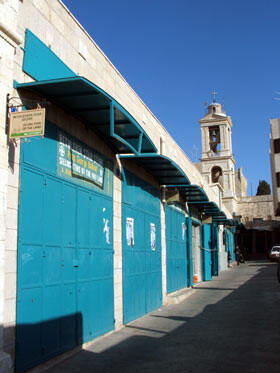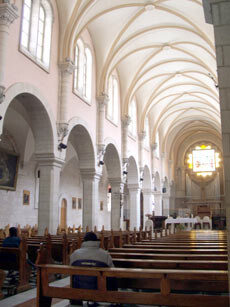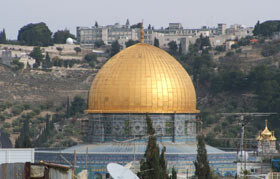
Shuttered souvenir shops along the Milk Grotto road in the Old City of Bethlehem (Maureen Clare Murphy)
However, cheerful international media reports on Bethlehem make it seem as though the historic town is enjoying a rebirth of tourism. An Associated Press article reports that the city is “often still full of tour buses,” and because of a November joint agreement between the Israeli and Palestinian Ministers of Tourism to cooperate to help build their respective tourism industries, the press is singing hopeful songs about the revival of religious pilgrims to the area.
It has been reported that during the Christmas season, an Israeli Tourism Ministry official will greet religious tourists with bags of sweets at the Gilo checkpoint that separates Bethlehem from Jerusalem, named after the illegal Israeli settlement nearby. But there was no such reception for this visitor Wednesday morning. Instead, I was made to wait on a bench for fifteen minutes while the bored Israeli soldiers flipped through a car magazine before they finally checked my passport and let me through, asking me brusquely in Arabic what I was intending to do in Bethlehem, and what I was planning on buying.
“The economy in Bethlehem is dramatically different now [since the beginning of the Intifada],” the shopkeeper in the Old City says, explaining that people are living off of savings accumulated during the tourism boom right after the Oslo Accords and before the current Intifada that broke out late September 2000. Unemployment is rampant, and in the last four years, nearly 10 percent of Bethlehem’s Christian population has immigrated abroad, causing much worry about the disintegration of the town’s cultural diversity.
Manger Square, which was bustling Wednesday with local children giddy with holiday excitement, is remarkably devoid of tourists despite the Christmas season. And when I walked down the Milk Grotto road, which leads from Manger Square to the site where legend has it that Jesus received his first feeding, more than half of the shops were closed. Workers at one of the opened stores were busily cleaning its very dirty windows, and it was clear that this was the first time the shop had been open in a long time.
Bethlehem has seen much trauma to its economy since the Intifada. A recent UN report informs, “a total of 28 hotels, 240 olive wood and mother-of-pearl workshops, and 50 restaurants have closed.” Fears of violence and Israeli intimidation and closure have stopped religious tourists from coming to both Israel and the Occupied Palestinian Territories, and those that do come to what they consider the Holy Land tend to spend most of their time in Jerusalem, and make only brief day trips to the Church of the Nativity in Bethlehem. Since approximately 18 percent of Bethlehem’s population was employed in the tourism sector before the Intifada, and the Annexation Wall that is ghettoizing Bethlehem continues to be built, the outlook is grim.
An hotelier tells me that before the Intifada, the situation was good. Built in 1999, his business was immediately successful, and he boasted its four-star rating. When it opened, the hotel employed 45 people, but currently it employs only eight. Though it has 85 rooms and 160 beds, the hotel sometimes goes by for a month with no customers. At the best times, the hotelier says, ten rooms are occupied. This, despite that before the Intifada the hotel was full all year. And even though Bethlehem is at its peak tourism season, only one of his rooms was occupied at the time of my visit.
He explains how tourists are intimidated by Israeli soldiers at the checkpoints that close off Bethlehem from Jerusalem and the rest of the West Bank. “The guides and tourists say when they come to Bethlehem, the soldiers at the checkpoints hold them up for such a long time that they think Bethlehem is unsafe,” so they are afraid to sleep in Bethlehem and they immediately return to Jerusalem after visiting Bethlehem’s holy sites.

Though the Church of the Nativity will be packed Christmas Eve, the number of tourists coming to the church built on the site believed to be the birthplace of Jesus has dropped off during the past four years (Maureen Clare Murphy)

The Old City of Bethlehem, where heavy fighting during April 2002, and which is now isolated by Israel’s wall and checkpoints (Maureen Clare Murphy)
And Israeli tour packages arrange it so that Christian tourists visit religious sites in Israel before coming to Bethlehem, so by the time they get to Bethlehem they have already spent most of their time and money. And because foreign tourists are too scared to come to the West Bank, most of the hotel’s customers are Palestinians from other areas of the West Bank, where the Israeli system of checkpoints and road closures make it too difficult to visit one city and return the same day. But unlike foreign tourists, Palestinian customers of the hotel stay only one night, rather than multiple nights.
In 2002, a group of Brazilian tourists were staying at the hotel when they went on a day trip to Jerusalem. When they attempted to pass back through Gilo checkpoint, which prevents free movement between Jerusalem and Bethlehem, they were initially denied access. When they explained to the Israeli soldiers that their documents and possessions were back at the hotel in Bethlehem, the soldiers confiscated their passports and gave them only one hour to retrieve their belongings from the hotel and return to the checkpoint.
Worse yet, during the summer of 2002, the Israeli soldiers set up a military base in the hotel, causing damage in excess of $10,000. Annoyed because the phone kept on ringing, they decided to destroy the $10,000 phone unit. Doorframes were damaged as well. And this hotel is not alone - the Bethlehem Inn sustained a devastating $2 million loss after Israeli soldiers occupied it for four years.
Though Bethlehem is not currently under siege as it was for 38 days in 2002, when Israeli troops attacked the Church of the Nativity, current Israeli actions are ensuring that economic recovery for Bethlehem will be a long time coming. The illegal Annexation Wall is being built around Bethlehem well away from the 1949 armistice line, not only cutting off residents from their land, but making access to the town all that more difficult to come by.
At the completely walled-in Rachel’s Tomb, which used to be home to a busy nightlife, there are currently only eight businesses whereas in 2002 there were 80. The wall cuts off the main artery from Jerusalem to Bethlehem, bleeding the area of all commerce and activity, though Jewish-Israeli tourists enjoy free access via special Jews-only bypass roads. While pre-Intifada two or three buses full of Christian tourists would come to the area daily, now a half-full bus comes only every two or three months, some men at a large souvenir shop tell me. They show me a package of batteries that expired in 2001, evidence of the freeze in tourism.
“When it rains, everybody gets wet,” one of the older men tells me. Making a point to explain that both Israeli and Palestinian tourism has suffered, he explains that the lack of tourism causes a chain reaction, and that it affects all industries. The shopkeepers’ frustration is palpable — everybody knows about the decline in tourism, they say, but nobody is doing anything about it. Indeed, as I later wandered around Manger Square, it was clear that there were more journalists than tourists, and through the problems of Bethlehem are being documented, change is not happening.

The Dome of the Rock at the Haram Ash-Sharif compound in the Old City if Jerusalem, one of the three most important sites in Islam (Maureen Clare Murphy)
Palestinian Muslims residing in Bethlehem and in the rest of the Occupied Palestinian Territories wanting to pray at the Al-Aqsa mosque in Jerusalem, the third holiest site to Muslims, experienced similar problems this year during Ramadan. According to the UN report, “In 2004, only men over 50 years and women over 45 years were allowed to cross at Gilo checkpoint to reach the Al-Aqsa Mosque. In practice, closures and sudden security alerts reduce the numbers of those actually able to pass.” And even within Bethlehem, Muslims are unable to access the Bilal Mosque, located at Rachel’s Tomb.
While the eve of a new year traditionally is a time of hope, until Israeli occupation practices are abated, there is little optimism for Bethlehem’s tourism industry and those who depend on it. But as the shopkeeper in the Old City tells me, “If we don’t have hope we will have everything to lose.”
Maureen Clare Murphy is currently in Ramallah doing an internship with the Palestinian human rights NGO Al-Haq, where this story was also published. She is also Arts, Music and Culture Editor for EI.
Related links:




